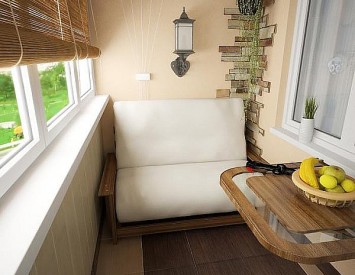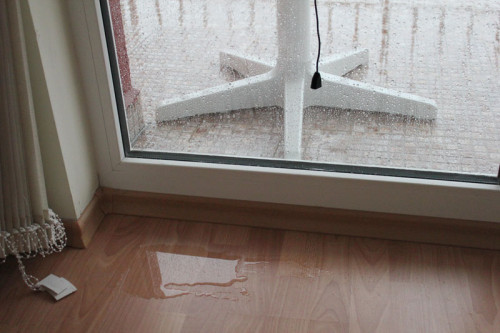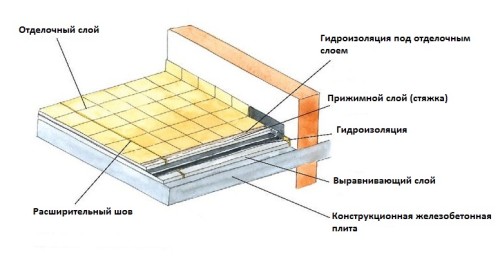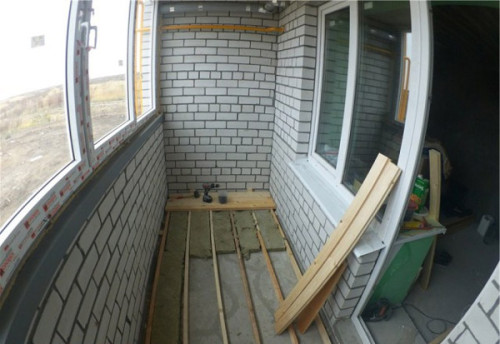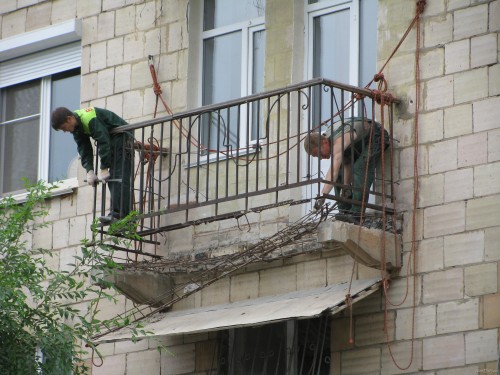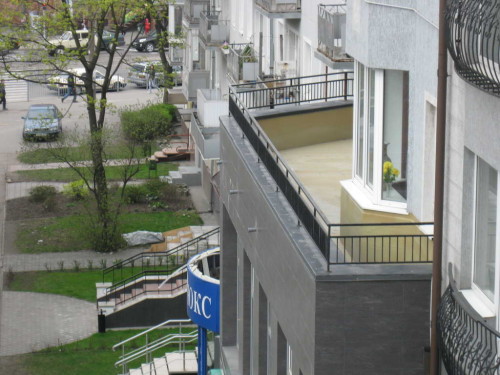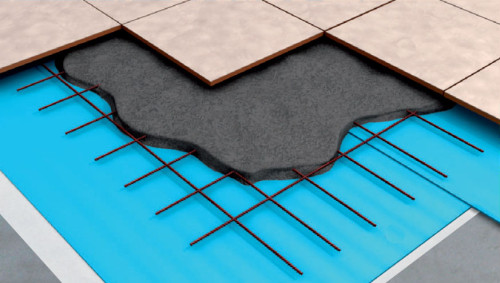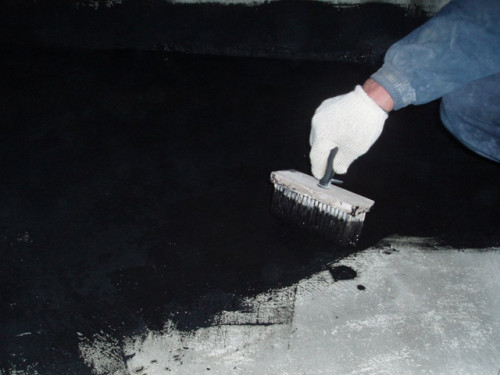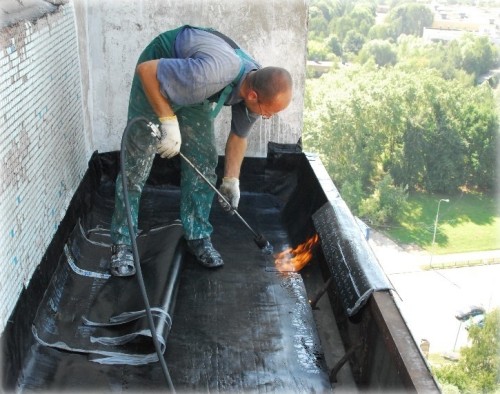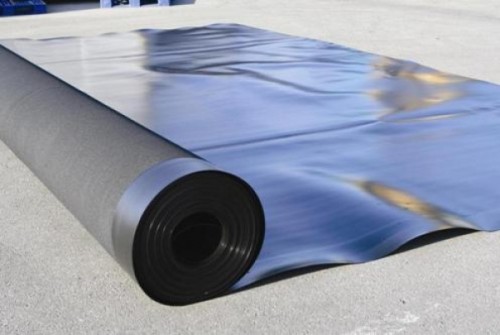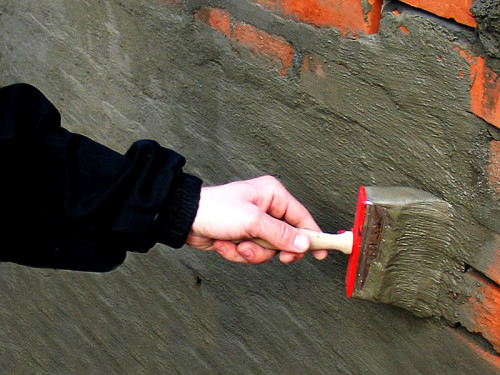The balcony or loggia can be a wonderful vacation spot both in a private house and in the apartment of a multi -storey building. And in order for the room to be comfortable, it is necessary to provide not only external comfort, but also reliable waterproofing, which can withstand a significant amount of precipitation. After all, the concrete or wooden base of the balcony in itself passes moisture, and as a result, damp or even fungus appears. And this, you see, does not have in any way to family gatherings in the fresh air or the arrangement of a magnificent winter garden.
At the same time, even if the balcony in your house is open (not glazed) - this does not mean that the waterproofing of the floor, ceiling and roof is not needed.
Content
- Why are leaks on the balcony
- What is the waterproofing of the balcony for
- What is waterproofing
- Preparation for the waterproofing of the balcony
- Materials for waterproofing balcony
- Secrets of successful waterproofing
- Cast waterproofing of the balcony with your own hands
- Do -it -yourself coating waterproofing
- How to independently perform the global waterproofing of the balcony
- DIY plastering waterproofing
- Subtleties of waterproofing the ceiling and roof of the balcony
- DIY waterproofing waterproofing: video
Why are leaks on the balcony
The most at risk during rains and melting snow is most at risk, of course, the ceiling of the balcony (even glazed). If there is a dry ceiling, then the floor will remain comfortable.
Why does the ceiling of the balcony or loggia become moist:
- On the roof of the balcony, the waterproofing coating has leaked. Especially such a problem is relevant for residents of old buildings, which have not been undergoing overhaul from utilities for a long time.
- Even if the house is quite new, the leak may occur due to a violation of waterproofing rules during glazing work. Therefore, even the balcony after recent repairs can soon become raw.
- Often the cause of leaks is the absence of a system of upper drain.
- If the waterproofing between the windows and the ceiling is not thought out during the installation of the frames on the balcony, then puddles and dampness will not make themselves wait long.
- If the house is old, then the cause of the leak may be the wear of the plate of the balcony ceiling itself.
What is the waterproofing of the balcony for
The owner of the balcony without waterproofing risks primarily by the fact that the walls and ceiling of the structure will be covered with mold or fungus. The most dangerous is the appearance of black mold: its disputes, spreading through the air, enter the respiratory system of a person, provoking various diseases. Other types of mold can cause a persistent unpleasant odor. And you don’t even have to talk about the aesthetic side of the question.
Waking up with moisture, the elements of the interior decoration of the balcony exfoliate and lose their original appearance. It may turn out that you in vain spent a large amount on cosmetic repairs of the balcony.
Under the constant effect of dampness, a slow, but true destruction of fasteners and metal structures of the balcony occurs. Thus, after ten years, the structure will simply become emergency - it will lose its supporting functions.
What is waterproofing
Waterproofing is the creation of a special layer that will protect the balcony from moisture penetration and its destructive effect on other structural elements. With properly equipped waterproofing, the service life, as well as the comfort of the room, increases significantly.
Not only the roof of the balcony or loggia needs waterproofing measures. Moisture can also come from below (from the floor) if the balcony or terrace is located on the ground floor - from the basement or soil. Actually, the loggias and balconies of the first floor need particularly carefully thought out waterproofing measures, as well as insulation and ventilation. And if your apartment is on the middle floor, then the waterproofing will protect you from leaks from neighboring balconies. The walls are subject to the destruction of moisture from the air, so the moisture -repellent layer should protect the entire surface of the structure.
So, waterproofing is a dense and strong layer of a special composition, which has waterproof and water -repellent properties to protect the floor, ceiling and walls of rooms, where there is a risk of moisture from the outside.
Preparation for the waterproofing of the balcony
First of all, you should know that construction standards suggest the presence on the balconies, terraces and loggias of the minimum slope for the natural drainage of water to the outside. But in order to protect yourself from stagnation of water, this is not enough.
The area of \u200b\u200bthe balcony is small, and modern waterproofing materials are so simple in circulation, then every homeowner can cope with the repair, who decided to start this repair. The main thing is to follow the instructions, correctly and carefully handle the materials and not make technological changes to the process if you are not completely sure of the success of your ideas.
The choice of material will also depend on how much you have the means and time for repair.
- first of all, dismantle the old coating;
- inspect the basis of the balcony: if it is concrete, then remove the parts that have become unusable with a punch;
- clean the surface of pollution (use a hard brush), as well as the remains of mounting foam, glue or cement;
- process and smear all cracks;
- remove rust from metal surfaces (it is better to use special chemical compounds);
- cover the metal elements with an anti -corrosion substance;
- level and restore the concrete base;
- determine the places on the roof of the balcony through which the moisture penetrates and conduct their additional sealing;
- when all preparatory work is completed, you can cover the balcony with waterproofing materials.
Materials for waterproofing balcony
To solve the problems of leaks in the construction market, there are a lot of materials differing in the method of application: liquid (capable of forming an even and reliable seamless coating over the entire surface) and roller materials (membranes and film).
Please note that different types of waterproofing are used for various surfaces.
- Crystal waterproofing. It is a coating of bitumen -based paints. It is applied in several layers. It is used for metal structures in order to protect them from corrosion.
- Plastering waterproofing. It is also applied in several layers on the reinforced concrete surface.
- Motorproofing waterproofing. Installation consists in pasting surfaces with a special material.
- Cast waterproofing. It is a layer of 5 cm thick from mastic and asphalt solution. It is rightfully considered the most reliable way to protect against moisture.
- Mounted waterproofing. Special sheets (metal or plastic) are attached directly to the walls of the building. This method is used when other materials are not used for some reason.
- Prophet waterproofing. Special organic compounds are covered with porous or prefabricated structures, such as pipes, blocks or slabs.
- Injection waterproofing. This method is chosen for sealing seams or for the repair of a finished waterproofing layer. To do this, furan resins are inserted into the joints or slots.
Secrets of successful waterproofing
Primer. Before applying liquid masses for waterproofing, it is necessary to primed the base. This will reduce its moisture -drinking properties. Experts recommend mineral compounds for priming, which need to be applied in 2 layers.
The joints of the balcony plates are better to additionally protect with sealing ribbons or special flexible profiles. This will allow you to insure the most susceptible leaks of the structure.
Use for balconies (both open and closed) liquid polyurethane compounds or two -component mineral mixtures. A huge plus of these modern materials in their elasticity: the layer is able to expand or narrow when temperatures oscillates and not give cracks.
For repair on the balcony, terrace or loggia, choose a clear day when the air temperature will be in the range from +5 oC to +25 oS. Neither too strong heat, nor frost will allow you to perform high -quality application of waterproofing drugs.
Liquid compositions are best applied in 2 layers. At the same time, the first is allowed to dry and absorb for 5-8 hours, and only then the second is applied. After the composition is distributed over the surface, provide it with protection from rain or direct sunlight for at least 2 hours.
In a day, it will be possible to proceed with the installation of the upper coating, which will protect the waterproofing layer from mechanical damage.
Cast waterproofing of the balcony with your own hands
This is equally a rather reliable and quite expensive way of waterproofing. It is suitable for those who do not want to constantly return to the issue of repairing the balcony, but is ready to once and for a long time to make the structure dry, warm and suitable for family vacations.
There are 2 methods for creating a cast moisture -repellent layer: hot and cold. Work is carried out quite simply. If you wish, you can perform them with your own hands, following the instructions.
The "hot" method:
- carefully clean the balcony floor: remove garbage, dust and dirt;
- if you find cracks, be sure to smear them and let the solution dry;
- then dry the surface to be processed with hot air (you can use a building hair dryer for this);
- dilute the bitumen to a liquid state and primed well the prepared surface;
- set along the perimeter of the processing zone of the side, the height of which is 30-40 cm;
- heat mastic to +135-145 oC and pour it on the floor;
- using scrapers, align the layer of mastic, distributing it over the entire surface;
- to create a reliable waterproofing layer, you need to apply 2-3 layers of mass-the total layer thickness will be 2.5 cm;
- if you want to give the coating additional strength, especially at the places of joints of balcony plates, use a metal mesh as a frame for applying a 5 mm cell.
The "cold" method. The principle of performance of work remains the same: cleansing, elimination of cracks, primer, applying mastic. However, the mixture in this case is not heated, but is applied in cold form.
Do -it -yourself coating waterproofing
As already mentioned, this method is suitable for protecting metal, reinforced concrete surfaces, as well as polyurethane and brick. A thin (about 2 mm) two-layer coating is applied in one way:
- cold (a mixture based on rubber resin is used);
- hot (a mixture based on bitumen and polymer varnishes is used).
Before you take the protective composition, clean the surface of dust, remove traces of corrosion, treat with a degreasing solution, apply a primer from bitumen and mastic.
The process of applying coating waterproofing is very simple: distribute the composition on the surface with a roller or brush (as you are more convenient) so that it turns out a thin, but uniform layer.
Crystaline (or as it is also called painting) waterproofing is very popular: each owner can easily apply the composition. In addition, the price of the material is low, and the service life will be 5-6 years, depending on the intensity of moisture. However, it is worth knowing that bitumen is destroyed when exposed to minus temperatures. Therefore, for external work, paint waterproofing material is unlikely to be suitable. More and more reliable will be mixtures with the inclusion of rubber and polymer components.
How to independently perform the global waterproofing of the balcony
Such a proven method is suitable for both the waterproofing of a wooden and concrete balcony. Perhaps the technique is familiar to everyone who has ever been repairing: special materials (sheet or roll) are glued to the surface in several layers.
However, glow waterproofing is used less and less: it gives way to more advanced technologies. Among the shortcomings that you must know about:
- before laying the material, the surface is subject to painstaking processing;
- the laying process itself is quite laborious: the material is heavy, its dimensions do not allow to turn freely on a small area;
- the material has a rather strong and stable smell, which will remain on your balcony for some time;
- in the places of connection of fragments of materials, seams are inevitably formed, which over time become the cause of leaks;
- the material is unstable to fluctuations in temperatures and begins to lose its qualities, moreover, it will also not protect from the development of microorganisms.
If the shortcomings of this method were not frightened and you decided to use it to waterproof the balcony or loggia, then the first thing is to choose the type of material:
- Bitumen-polymer waterproofing (this type includes filizol and isoplast, bicroplast, as well as ecarbites).
- Bitumin-rolled waterproofing (for example, roofing ruboroid or isol).
- Polymer waterproofing (polyvinyl chloride, polyethylene or synthetic rubber).
Remember that such a waterproofing layer must be protected from loads, for example, using a concrete screed.
DIY plastering waterproofing
As materials, special cement solutions and mixtures of polymers are used. You can use this method of protection against moisture on any surface.
- clean the surface of dust and lay down the seams and cracks;
- apply a primer and give it time to completely dry;
- prepare a solution for plaster;
- apply the first layer of the waterproofing composition (layer thickness 1-1.5 cm);
- drive special attention when processing to the corners and joints;
- wait 30 minutes;
- when the first layer dries - apply the second;
- it is necessary to make 3-4 layers;
- let the solution dry for several days, at this time avoid any mechanical effects on it;
- it is very important that the waterproofing layer does not dry out during the hardening process-moisten it with water from the spray gun every 3 hours for a day, and then 2-3 times a day for another 14 days.
Work on laying roll material:
- on the prepared surface, it is necessary to distribute the layer (1 mm) of the bitumen mastic;
- lay out waterproofing material and fix it;
- to create several layers-repeat the procedure 2-3 times;
- places of joints and edges should be processed.
Subtleties of waterproofing the ceiling and roof of the balcony
Protection against flowing from above is carried out in the following sequence:
- The roof is isolated by roofing material (the material is necessarily overlapping).
- Moisture -proof mastics are applied.
- Installation of an additional roof (most often this is done on the upper floors).
- F joint processing.
- Installation of the casting system of rainwater.
- Interior waterproofing (ceiling processing) in two layers - especially in places of joints of plates, ceiling and window frames, tiles and tide systems. However, it is worth knowing that if the outer part of the roof is poorly protected. Then internal finishing work will not save you from leakage.
